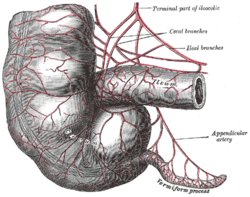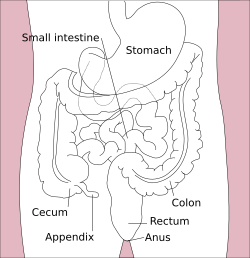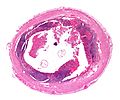Vermiform appendix facts for kids
Quick facts for kids Vermiform Appendix |
|
|---|---|
 |
|
| Arteries of cecum and vermiform appendix. (Appendix visible at lower right, labeled as "vermiform process"). | |
 |
|
| Normal location of the appendix relative to other organs of the digestive system (frontal view). | |
| Latin | appendix vermiformis |
| Gray's | subject #249 1178 |
| System | Digestive |
| Artery | appendicular artery |
| Vein | appendicular vein |
| Precursor | Midgut |
| MeSH | Appendix |
| Dorlands/Elsevier | Vermiform appendix |
In human anatomy, the appendix is a small, finger-shaped organ. It is connected to the cecum, which is the beginning of your large intestine. You can find it near where your small intestine meets your large intestine.
The word "vermiform" comes from Latin. It means "worm-like in appearance." This describes the appendix's shape very well. For a long time, scientists thought the appendix had no real job in humans. They called it a vestigial organ. This means it's an organ that has lost its original purpose over time.
Why Do We Have an Appendix?
Many years ago, Charles Darwin suggested a possible reason for the appendix. He thought that our very early ancestors, like ancient primates, might have used it. It could have helped them digest tough plant materials, such as leaves.
Over thousands of years, human diets changed. We started eating foods that were easier to digest. Because of this, the appendix slowly became smaller. It made room for other organs, like the stomach. It became a vestigial organ, meaning it no longer has a big job in our bodies.
Other animals, especially plant-eating mammals like the Koala, have much larger appendices. They also have other special body parts. These help them break down tough plant parts like cellulose. For example, a koala's cecum is very long. This long cecum holds special bacteria that can break down cellulose.
Our early human ancestors might have also relied on a similar system. They likely ate a lot of plants. But as humans started eating foods that were easier to digest, they needed cellulose-rich plants less.
A Safe Place for Good Bacteria
Even though the appendix is small, some recent research suggests it might have a job after all. It could be a safe place for helpful bacteria that live in your gut. These "good" bacteria are important for your digestion.
Sometimes, when you get sick, like with a bad stomach bug, these good bacteria can get flushed out. The appendix might act like a "safe house" for them. It's located in a spot that's somewhat protected from the normal flow of food and germs. It also has a lot of immune system tissue around it.
Studies have shown interesting things. For example, people who have had their appendix removed might be more likely to get certain gut infections again. This suggests the appendix could help "repopulate" your digestive system with good bacteria. It's like a backup supply after you've been sick.
Images for kids
-
Cross section of the appendix with Enterobius with H&E stain
See also
 In Spanish: Apéndice vermiforme para niños
In Spanish: Apéndice vermiforme para niños



